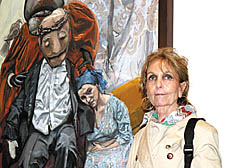|
|
 |
| |

Paula Rego in front of The Fisherman triptych. |
Rego’s grand vision
The artist Paula Rego talks to Dan Carrier about her inspirations, her work, and a love of EastEnders
BEFORE a stroke of Paula Rego’s brush touches the canvas, she applies her skills as a sculptor.
“I make models of the creatures I want to paint,” says Rego, a native of Portugal, but a resident of Hampstead and one of Britain’s most celebrated artists.
Last year she had a show at the Tate Modern, and now has a new exhibition at the Marlboro Fine Art gallery in D’Arblay Street, Mayfair. Her works – which can fetch up to £200,000 – are created in small studio in Kentish Town, however.
As well as using real people, she buys lots of pairs of tights. These are stuffed with rags and then a scarecrow like forms are created.
She settles them in to the poses she is looking for, again with the help of a model, and the grotesque, distorted semi-human forms she paints are created in real life, a form of cloth sculpture for her imagination to work from.
Rego has grand vistas on her canvases – her Catholic background is often displayed, by the themes she tackles, which include such imagery as crucifixion.
One painting focuses on Dante’s Divine Comedy. Heaven is represented at the top of the work by children playing a beach which looks like a summer scene in the Algarve. Others include the president of Portugal – a celebration of the republic instead of the dictatorship under which she grew up – and boasts flags and pageantry. But her own studio is far removed from such grandiose ideas, requiring spectacular leaps of imagination.
“The roof is leaking and things are quite damp there at the moment,” she says.
Rego was nominated for the Turner Prize in 2000 and thinks the concept is “wonderful”.
But she admits she hasn’t taken the time to look at this year’s nominations.
“I can’t say whether they are any good or not because I haven’t had the time to see them,” she says.
But she dismisses the idea that many of the conceptual artists are not worth the paper they are not painted on.
“Art is also about vision, as well as technique,” Rego explains. “Of course it is wonderful to see art that has been produced by incredible technique, technique honed by discipline, by practise, by application. But vision is an important part of the creative process as well, and much modern art, which is treated with disdain, is about vision, not technique.
“We all have vision. That is why there is an artist inside us all. You have to practise to hone technique, but there is still an inherent artistic ability within each of us.”
Her technique comes from a strict regime. Her current show took three years to put together.
“I have a timetable,” she says. “I go to the studio at 10 in the morning and don’t leave until seven, when I dash home to watch EastEnders.”
Her own inspiration comes from the love of storytelling.
She spent some time in the early part of her career illustrating children’s books and still tries to create a picture that has a tale behind it.
One of a series of pictures on display at the exhibition is entitled the Princess and the Pig – and is taken from a 16th-century story she found.
She explains: “A queen gives birth. But instead of a baby, she gives birth to a piglet.
“When he grows up, the pig must find a wife. He approaches three sisters. The first two do not want to marry him, but the third does. As they are in bed having sex, the pig sheds his skin and turns in to a handsome man. The Queen quickly takes the skin and burns it, so he has to stay a man.”
And other paintings draw directly on her memories as a child. One, with an octopus flailing around at the foot of the picture, draws directly on her early life.
“I recall fishing with my father at the most furthest most western point on the Portuguese coast, and the water there is extremely deep,” she says.
“He hauled out of the depths an incredible octopus – it was giant. My mother was disgusted by it – she said you can’t bring that out, you have to let it go. It has stuck with me.”
Rego moved to London in the late 1950s to study art. “My father was a confirmed Anglophile and I found it as wonderful as he did,’ she said.
And she marvels at how her adopted home has changed, and giggles at the culture shock she had to face when she first arrived.
“Art students of course liked to get drunk, but it was never wine. You couldn’t get wine, except something red and very heavy, and always from south Africa. The students would drink beer instead – I couldn’t stand it, so I’d drink lots of shandy. And as for olive oil – they only sold it in chemists.”
Rego has also watched Camden change.
“I started off in a hostel with four physiotherapists in a big house in the poshest street in St John’s Wood. Can you imagine that now?”
She then moved to digs in Albert Street. “It was not like it is now,” she recalls. “It was very, very poor. We had a family of four people living in just one room in the home we shared.”
“I miss Portugal – but north London is my home now.”
|
 |
|
 |
|

